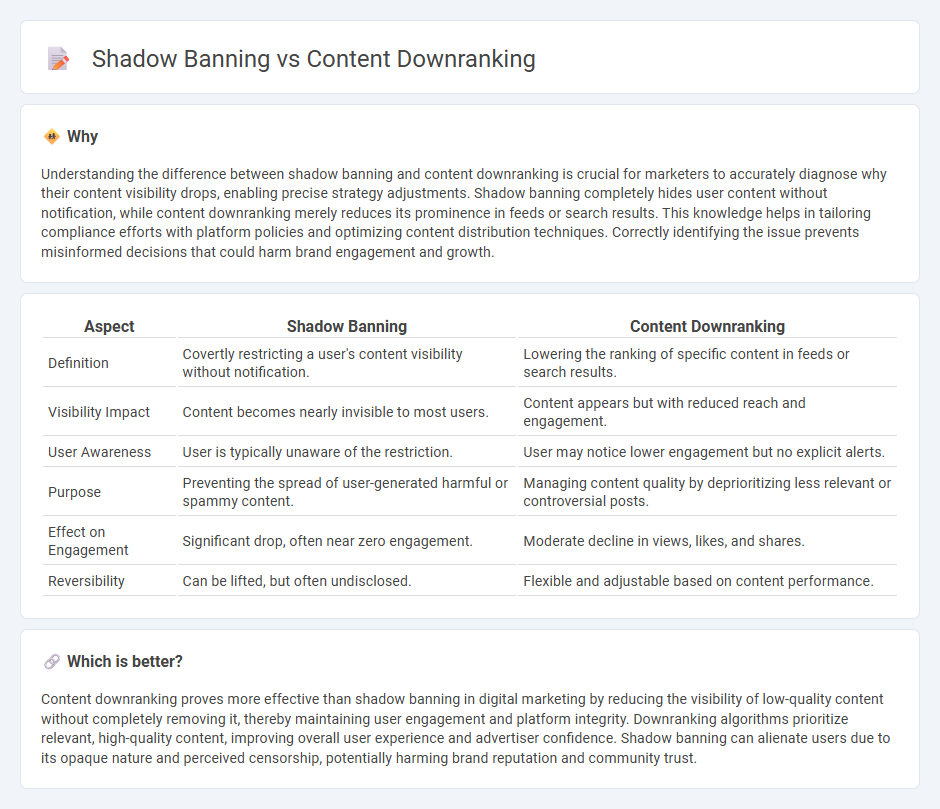
Shadow banning limits the visibility of user content without notification, causing significant drops in engagement across social media platforms like Instagram and Twitter. Content downranking, by contrast, reduces content priority in feeds or search results but does not entirely hide posts, impacting advertiser reach and organic growth metrics. Explore further to understand how these practices influence your digital marketing strategy.
Why it is important
Understanding the difference between shadow banning and content downranking is crucial for marketers to accurately diagnose why their content visibility drops, enabling precise strategy adjustments. Shadow banning completely hides user content without notification, while content downranking merely reduces its prominence in feeds or search results. This knowledge helps in tailoring compliance efforts with platform policies and optimizing content distribution techniques. Correctly identifying the issue prevents misinformed decisions that could harm brand engagement and growth.
Comparison Table
| Aspect | Shadow Banning | Content Downranking |
|---|---|---|
| Definition | Covertly restricting a user's content visibility without notification. | Lowering the ranking of specific content in feeds or search results. |
| Visibility Impact | Content becomes nearly invisible to most users. | Content appears but with reduced reach and engagement. |
| User Awareness | User is typically unaware of the restriction. | User may notice lower engagement but no explicit alerts. |
| Purpose | Preventing the spread of user-generated harmful or spammy content. | Managing content quality by deprioritizing less relevant or controversial posts. |
| Effect on Engagement | Significant drop, often near zero engagement. | Moderate decline in views, likes, and shares. |
| Reversibility | Can be lifted, but often undisclosed. | Flexible and adjustable based on content performance. |
Which is better?
Content downranking proves more effective than shadow banning in digital marketing by reducing the visibility of low-quality content without completely removing it, thereby maintaining user engagement and platform integrity. Downranking algorithms prioritize relevant, high-quality content, improving overall user experience and advertiser confidence. Shadow banning can alienate users due to its opaque nature and perceived censorship, potentially harming brand reputation and community trust.
Connection
Shadow banning and content downranking both involve the deliberate reduction of content visibility on digital platforms to limit user reach without outright removal. Algorithms detect content flagged for policy violations or low engagement, triggering shadow banning or downranking actions that suppress exposure in feeds and search results. These techniques serve to manage community standards and curate user experience by subtly controlling content distribution.
Key Terms
Visibility
Content downranking reduces the visibility of posts by lowering their ranking in feed algorithms, making them less likely to be seen without notifying the user. Shadow banning restricts content reach more severely by hiding posts or user activity entirely from the community, often without any alert. Explore how these visibility strategies impact social media engagement and content discoverability.
Algorithm
Content downranking reduces the visibility of posts by tweaking algorithmic signals like engagement metrics and relevance without notifying the user, while shadow banning entirely restricts content reach or account visibility, often hiding it from search and feeds. Algorithms assess factors such as user interaction, content quality, and compliance with platform policies to determine the severity of content suppression on social networks. Explore how major platforms implement these techniques to understand their impact on digital presence and content strategy.
Engagement
Content downranking reduces the visibility of posts in user feeds based on engagement metrics like likes, comments, and shares, aiming to limit the reach of low-quality or irrelevant content. Shadow banning covertly restricts a user's content visibility without notifying them, often applied to accounts that violate platform policies or generate negative engagement. Explore detailed differences and strategies for maximizing engagement in your content management approach.
Source and External Links
Ranking and Recommendation Systems - Downranking is an algorithmic method used by platforms like Facebook to reduce the distribution of misleading content by lowering its visibility, but it does not remove such content entirely and may not fully prevent its spread.
Common Mistakes That Result In Google Penalties - In SEO, downranking refers to algorithmic penalties that cause a website or specific pages to rank lower in Google search results, often due to issues like poor content quality, keyword stuffing, or slow page load speeds.
Measuring the effect of Facebook's downranking interventions against groups and websites that repeatedly share misinformation - Facebook's downranking interventions target groups and sites that frequently share misinformation by reducing their visibility, which can halve engagement for pages sharing misinformation repeatedly, though the impact on groups is less clear.
 dowidth.com
dowidth.com